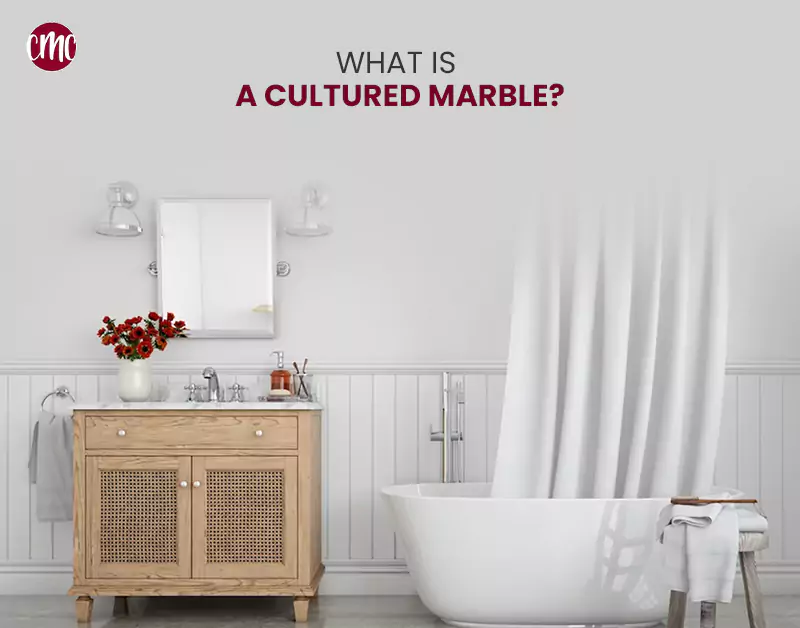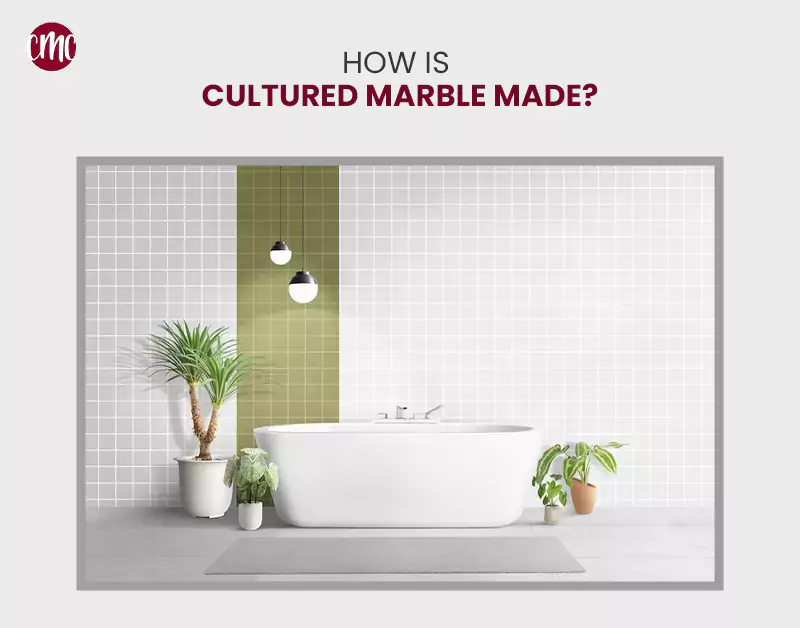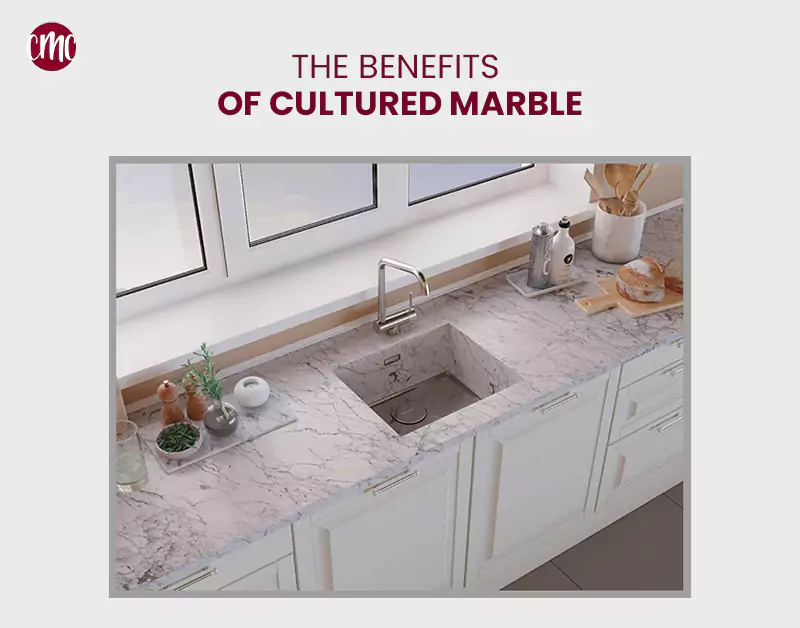Discover about cultured marble with our comprehensive guide. From its composition and production process to its uses and advantages, we’ve examined it all. Whether you’re considering it for countertops, vanities, showers doors, or other surfaces, learn everything in this blog!
What Is A Cultured Marble?

Cultured marble is a synthetic material that combines crushed marble or limestone with a resin binder. This mixture is molded and cured to create various products. This includes countertops, sinks, and shower walls.
Cultured marble is designed to resemble the appearance of natural marble but is more affordable and customizable. It offers a durable, low-maintenance surface with a smooth and glossy finish. This makes it a popular choice for homeowners seeking an elegant, cost-effective alternative to natural marble.
How Is Cultured Marble Made?

Cultured marble is made by mixing crushed natural marble or limestone with a resin binder. The general procedures for creating cultured marble are as follows:
Preparation
Chips of marble or limestone are among the raw materials chosen for the process. They are crushed to a specific size. The chips generally have a diameter of 3/8″ to 1/4″.
Mixing
The crushed pieces and a liquid polyester resin binder are mixed. This binder holds the marble fragments together. It functions as glue.
Coloring
Pigments or dyes can be added to the mixture for the appropriate color or veining look. This makes it possible to produce a wide variety of colors and patterns.
Casting
Molds typically constructed of fibreglass or another appropriate material are filled with the blended substance. Naturally, the molds are formed to produce the desired output, such as a sink or countertop.
Curing
After being filled, the molds are put in a temperature-controlled setting. This way, the resin can cure and solidify. Usually, it takes many hours to finish this operation.
Finishing
The goods made of cultured marble are taken out of the molds after curing. They are then polished and sanded to provide a shiny, smooth appearance. Additional details, such as edge profiles or surface textures, can also be added during this phase.
Quality Control
The final items go through extensive examinations. This ensures they adhere to the specified specifications and quality requirements.
How to Cut Cultured Marble?

Cultured marble must be handled carefully and cut using the proper equipment. Here is an overview of you can cut cultured marble:
Safety Precautions
Before beginning, ensure you have the necessary safety gear, such as a dust mask, gloves, and safety glasses. They are to protect you from any potential risks during cutting cultured marble.
Mark the Area
On the surface of the cultured marble, measure and mark the area you wish to carve. To draw crisp and clean lines, use a pencil or marker.
Choose the Correct Blade
Choose a wet saw or circular saw that has a diamond-tipped blade. This one is made especially for cutting marble or manufactured stone. These blades can safely and effectively cut through cultured marble without breaking or cracking.
Cutting Technique
Slowly and steadily move the saw along the specified line to make straight cuts. Keeping the cutting speed constant is essential to avoid overheating and potential material damage.
Finish the Edges
After the initial cut, polish the cut edges using a diamond polishing pad or fine-grit sandpaper. This action contributes to a polished and professional impression.
How to Clean Cultured Marble?

Now you must be wondering how to clean cultured marble. Cultured marble can be cleaned relatively easily. However, it’s crucial to employ mild cleaning techniques and avoid abrasive chemicals that might harm the surface.
Gather Materials
Warm water, soft cloth or sponge, light soap or a pH-neutral cleanser, and a drying towel are essential.
Clean Up
Clean the cultured marble surface with a soft cloth or sponge with warm water. This aids in cleaning off any dirt or loose particles.
Make a Cleaning Agent
Warm water and a small amount of mild soap or a pH-neutral cleanser are used. Combine it in a bucket or sink. If using a specific cleaning, adhere to the dilution ratio recommendations provided by the manufacturer.
Clean the Area
Gently wipe the cultured marble surface after dipping a soft cloth or sponge into the cleaning solution. Wring out any remaining moisture. Use gentle circular strokes to clean the whole space, paying close attention to any stains or spots.
Rinse and Dry Thoroughly
Rinse the cloth or sponge with clean water to eliminate any soap residue left on the surface after washing. Wipe it off a few times. Use a dry, clean towel to dry the cultured marble surface thoroughly. This process aids in avoiding water stains or streaks.
Polish
To increase the gloss, you can use cultured marble polish. Follow the application and buffing guidelines provided by the manufacturer. This step will only add extra glow during the cleaning cultured marble process.
The Benefits of Cultured Marble

Cultured marble offers several benefits, making it a popular choice for various applications. Here are some of the main advantages of Cultured Marble.
Appearance
Cultured marble mimics genuine marble in appearance due to its glossy, smooth texture. There are many cultured marble colors. It comes in various hues and designs, including veining that resembles marble. The surface is aesthetically pleasing and gives any area a touch of elegance.
Durability
The resilience of cultured marble is well recognized. It is a sensible option for high-traffic areas since it resists cracks, chips, and scratches. It is also non-porous, which makes it simpler to maintain and keep clean and helps to prevent stains. So, the answer to the question is cultured marble is durable, yes!
Low Maintenance
Cultured marble requires less upkeep. Its non-porous surface prevents stains, the formation of mold, and mildew. Most of the time, a regular cultured marble cleaner is sufficient to maintain its outstanding appearance. It is an easy option for busy homes because it needs little maintenance.
Budget Friendly
Compared to genuine marble, cultured marble is more affordable. While maintaining the exquisite appearance of marble, it provides a more affordable option. It allows homeowners to complete various renovations within their budget while achieving the desired look.
Comparing Cultured Marble with Natural Marble

Cultured marble is an identical material but not actual marble. It is an artificial substance. Natural marble is grounded and combined with synthetic resins, dyes, and coatings. This process creates cultured marble.
Here are a few of the differences between Cultured Marble and Natural Marble.
Cultured Marble vs. Natural Marble: Appearance
Many cultured marble colors are intended to imitate actual marble surfaces. It has a glossy texture, so some may say it looks almost exactly like marble.
From a distance, cultured and natural marble can appear to be the same. However, even someone with no prior understanding of countertop materials will be able to see the difference up close.
Cultured Marble vs. Natural Marble: Maintenance
Compared to actual marble, cultured marble is simpler to clean. Because cultured marble is non-porous, it is less likely to etch or become stained. It is cleanable with water and mild soap. There are many best cleaners for cultured marble showers available in the market.
On the other hand, natural marble is porous. It should be treated differently to prevent damage from acidic or abrasive cleansers.
Cultured Marble vs. Natural Marble: Cost
Natural marble is typically more expensive than cultured marble. Real marble is a natural stone, and because of its scarcity and labour-intensive extraction procedure, it can be more expensive. For those searching for the appearance of marble at a more affordable price, cultured marble offers a cost-effective substitute.
Conclusion
Cultured marble is an affordable and customizable alternative to natural marble. It provides a rigid, low-maintenance surface with a glossy, smooth finish. Although it might not have all the qualities of natural marble, it has a beautiful appearance and costs less.


